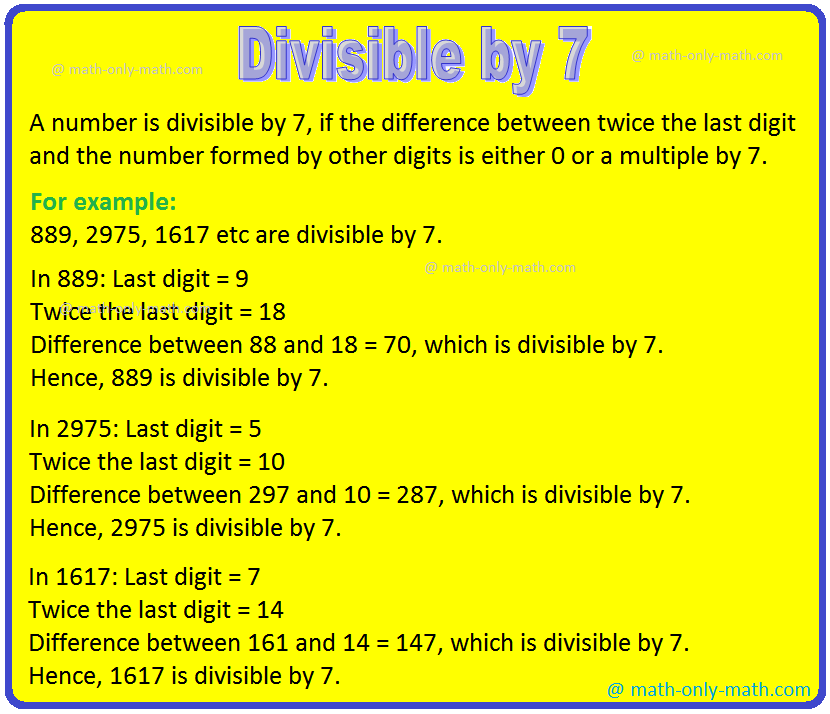Subscribe to our ▶️ YouTube channel 🔴 for the latest videos, updates, and tips.
Divisible by 7
Divisible by 7 is discussed below:
We need to double the last digit of the number and then subtract it from the remaining number. If the result is divisible by 7, then the original number will also be divisible by 7.
Divisibility Rule for 7 Video
Subscribe to our ▶️ YouTube channel 🔴 for the latest videos, updates, and tips.
I: Consider the following numbers which are divisible by 7, using the test of divisibility by 7: 133, 273, 329, 595, 672.
(i) 133
In the number 133, double the last digit of the number 3 is 6. 13 – 6 = 7 [Now we need to subtract it from the rest of the remaining number]
Since 7 is divisible by 7.
Hence, 133 is also divisible by 7.
What is the divisibility rule of 6 with example?
(ii) 273
In the number 273, double the last digit of the number 3 is 6. 27 – 6 = 21 [Now we need to subtract it from the rest of theremaining number]
Since 21 is divisible by 7.
Hence, 273 is also divisible by 7.
(iii) 329
In the number 329, double the last digit of the number 9 is 18. 32 – 18 = 14 [Now we need to subtract it from the rest of the remaining number]
Since 14 is divisible by 7.
Hence, 329 is also divisible by 7.
(iv) 595
In the number 595, double the last digit of the number 5 is 10. 59 – 10 = 49 [Now we need to subtract it from the rest of the remaining number]
Since 49 is divisible by 7.
Hence, 595 is also divisible by 7.
(v) 672
In the number 672, double the last digit of the number 2 is 4. 67 – 4 = 63 [Now we need to subtract it from the rest of the remaining number]
Since 63 is divisible by 7.
Hence, 672 is also divisible by 7.
II: Consider the following numbers which are not divisible by 7, using the rules of divisibility by 7: 167, 233, 297, 305,317.
(i) 167
In the number 167, double the last digit of the number 7 is 14. 16 – 14 = 2 [Now we need to subtract it from the rest of the remaining number]
Since 2 is not divisible by 7.
Hence, 167 is also not divisible by 7.
(ii) 233
In the number 233, double the last digit of the number 3 is 6. 23 – 6 = 17 [Now we need to subtract it from the rest of the remaining number]
Since 17 is not divisible by 7.
Hence, 233 is also not divisible by 7.
(iii)297
In the number 297, double the last digit of the number 7 is 14. 29 – 14 = 15 [Now we need to subtract it from the rest of the remaining number]
Since 15 is not divisible by 7.
Hence, 297 is also not divisible by 7.
(iv) 305
In the number 305, double the last digit of the number 5 is 10. 30 – 10 = 20 [Now we need to subtract it from the rest of the remaining number]
Since 20 is not divisible by 7.
Hence, 305 is also not divisible by 7.
(v) 317
In the number 317, double the last digit of the number 7 is 14. 31 – 14 = 17 [Now we need to subtract it from the rest of the remaining number]
Since 17 is not divisible by 7.
Hence, 317 is also not divisible by 7.
Problems on Divisibility Rules
Worksheet on Divisibility Rules
From Divisible by 7 to HOME PAGE
Didn't find what you were looking for? Or want to know more information about Math Only Math. Use this Google Search to find what you need.



New! Comments
Have your say about what you just read! Leave me a comment in the box below. Ask a Question or Answer a Question.